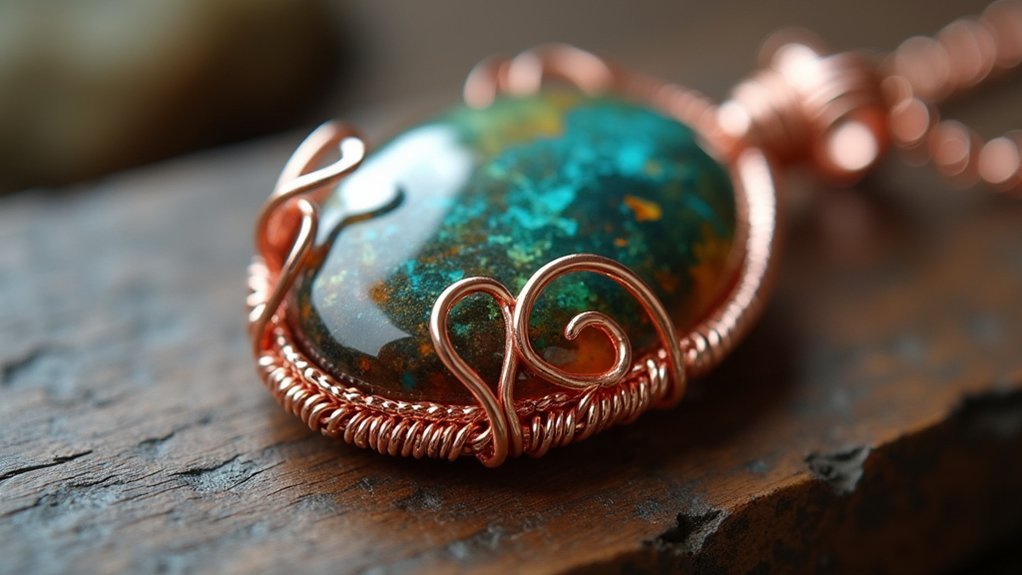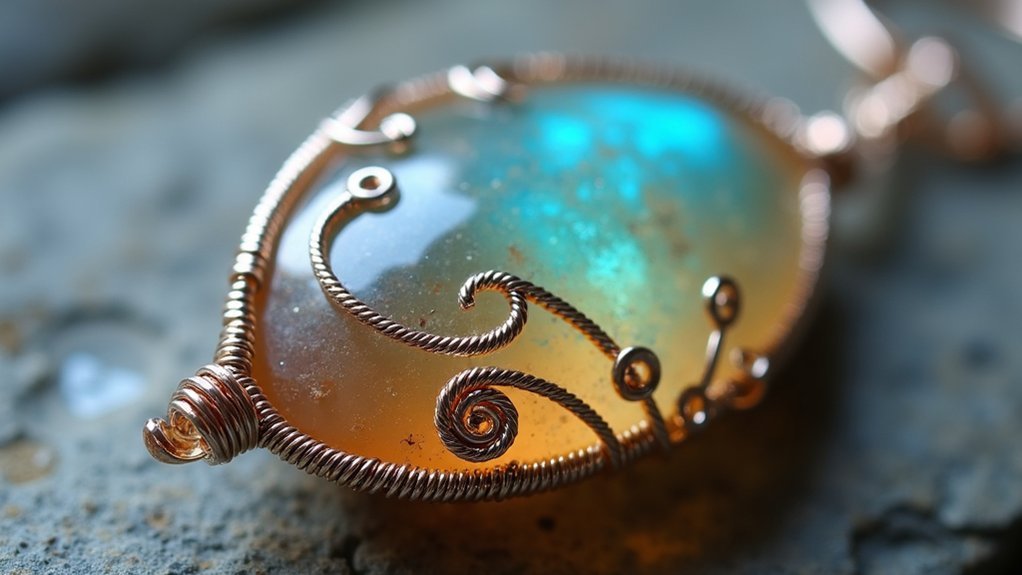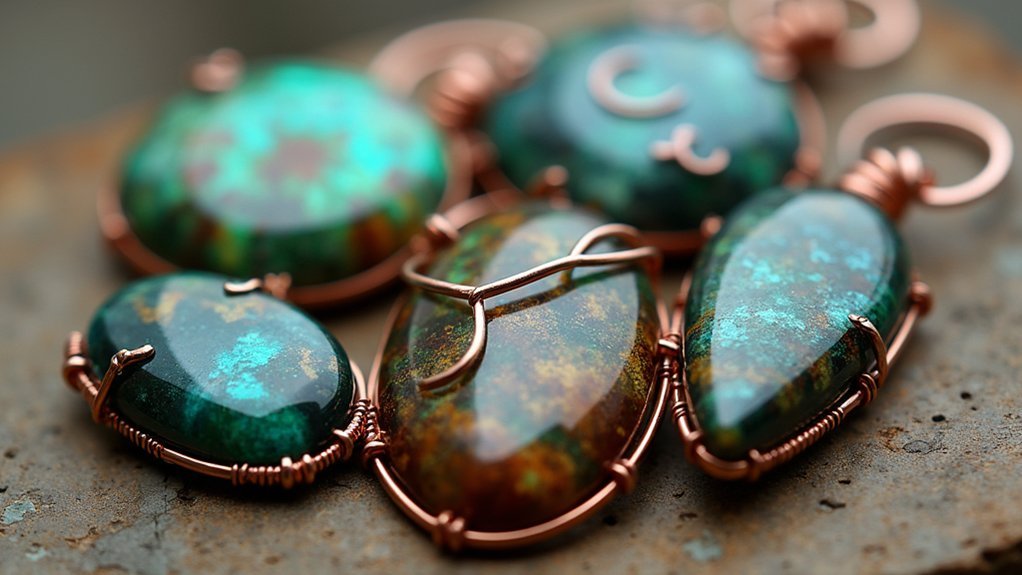You’ll create stunning wire-wrapped cabochon pendants by following five essential techniques. Choose the right wire gauge for your stone size—22-gauge for stones under 18mm, 20-gauge for medium stones, and 18-gauge for larger cabochons. Build a secure three-wire base framework and bind it with thinner wire. Master consistent wrapping tension using flat-nose pliers for professional results. Position your cabochon with the rounded side forward for ideal display. Complete your piece with a properly constructed bail and decorative loops for enhanced style and structural support.
Choose the Right Wire Gauge for Your Cabochon Size

When selecting wire for your cabochon project, you’ll find that the gauge directly impacts both the security of your wrap and the overall aesthetic of your finished piece.
For wire wrapping smaller cabochons up to 18mm, 22-gauge sterling silver wire provides delicate detailing while maintaining security.
Medium-sized stones between 18mm and 25mm work best with 20-gauge wire, offering the perfect balance of strength and workability for intricate designs.
Larger cabochons over 25mm require 18-gauge wire for proper support and durability.
Your cabochon size determines the appropriate wire gauge, but also consider the stone’s thickness—thicker cabochons need heavier wire.
Choose half-hard wire for ideal shape retention while remaining workable during your wire wrapping process.
Create a Secure Base Framework for Stone Stability
Every successful wire-wrapped cabochon starts with a solid foundation that’ll keep your stone secure throughout the wrapping process.
Creating a secure base framework requires careful attention to wire selection and wrapping technique to guarantee your cabochon stays firmly in place.
Start with three pieces of 0.6mm wire cut long enough to wrap around your cabochon completely. These base wires form the structural backbone of your setting.
Use 0.3mm wire to bind the wires together tightly, creating a unified framework that won’t shift during construction.
Here’s your step-by-step approach:
- Position the base wires around your cabochon’s perimeter for proper fit
- Cross and secure the back wires with additional wrapping for stability
- Add decorative loops on each side while securing for enhanced structural support
Master the Proper Wrapping Tension Techniques

Once you’ve established your solid base framework, proper tension control becomes the foundation of professional-quality wire wrapping.
You’ll need to maintain consistent pressure as you wrap wires around your cabochon—too loose creates fragile structures, while excessive tightness risks damaging the stone or distorting your design.
Start with lighter gauge wire like 0.3mm for intricate work, as it’s more forgiving when adjusting tension. Use flat nose pliers to secure and compress each wrap, pressing layers tightly against previous ones for a polished finish.
Bend your base wires snugly around the stone’s edges to distribute tension evenly throughout the piece.
Regularly check for unevenness during wire wrapped jewelry making. If you notice irregularities, gently adjust with pliers before continuing to guarantee professional results.
Position Your Cabochon for Optimal Display and Security
Proper cabochon positioning determines both the visual impact and structural integrity of your finished piece. You’ll want to place the rounded side facing forward to maximize visual appeal while creating a stable foundation.
Position your base wires around the cabochon’s perimeter, forming a snug fit that eliminates gaps. Bend the front setting wires inward to secure the stone firmly against movement.
Here are three essential positioning techniques:
- Create a flat seat – Measure and adjust wire lengths to guarantee your cabochon sits evenly within the setting.
- Use two wires for support – Position base wires to support the back while front wires hold securely.
- Check wrap tightness – Verify the wires around your cabochon maintain proper tension to prevent loosening over time.
Finish With Professional Bail and Loop Construction

With your cabochon securely positioned, you’ll need to create a professional bail that transforms your wire-wrapped stone into a wearable pendant.
Separate the front two wires from the base and wrap them tightly several times to form a sturdy loop. Measure and mark approximately 3cm for the bail wrap, then trim the wire 2cm past the wrap end for a clean finish.
Creating a secure bail requires precise wire separation, tight wrapping, and proper trimming for professional pendant results.
Bend the bail wires upward at a 45-90 degree angle after wrapping to create a graceful curve. Tuck the trimmed wire ends into the space above the stone to eliminate sharp edges and maintain a polished look.
For added style, incorporate decorative swirls or loops around the bail, ensuring they’re securely wrapped and positioned to enhance your design.
Frequently Asked Questions
How to Wrap Wire Around Stones for Jewelry?
You’ll start with three 20cm wires, secure them with finer wire, bend around your stone’s edges, cross back wires for stability, create decorative loops, then attach a chain for wearing.
What Is the Best Wire for Wire Wrapping Stones?
You’ll want 20-22 gauge wire for best results. Choose sterling silver half-hard wire for durability and beauty, or copper wire if you’re starting out since it’s affordable and forgiving to work with.
What Gauge Wire for Wrapping Rocks?
You’ll want 20-gauge wire for your main rock wrap structure, then switch to 22-gauge for decorative details. Consider your rock’s weight—heavier stones need thicker wire for proper support and stability.
Why Do People Wire Wrap Crystals?
You’ll wire wrap crystals to create beautiful handcrafted jewelry that showcases each stone’s natural beauty while securely holding it in place. You’re also enhancing the crystal’s metaphysical properties and creating durable, wearable art pieces.
In Summary
You’ve now got the essential techniques to create stunning wire-wrapped cabochon jewelry. Remember to match your wire gauge to your stone size, build a solid foundation, maintain consistent tension throughout your wraps, and position your cabochon for maximum visual impact. Don’t forget to finish with a professional bail that’ll showcase your work beautifully. With practice, you’ll develop your own signature style and create pieces you’ll treasure forever.





Leave a Reply